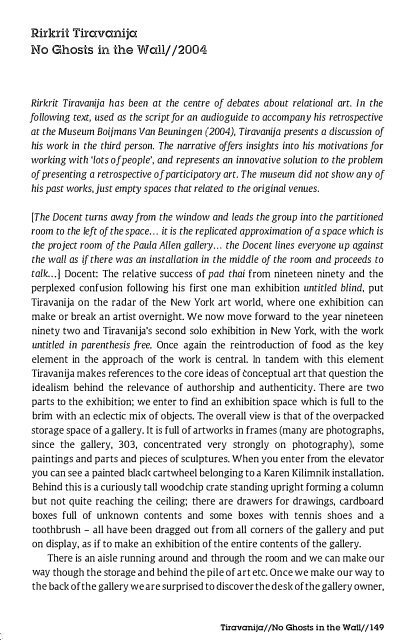You also want an ePaper? Increase the reach of your titles
YUMPU automatically turns print PDFs into web optimized ePapers that Google loves.
Rirkrit Tiravcmija<br />
No Ghosts in the Walll12004<br />
Rirkrit Tiravanija has been at the centre of debates about relational art. In the<br />
following text, used as the script fo r an audioguide to accompany his retrospective<br />
at the Museum Boijmans Van Beuningen (2004), Tiravanija presents a discussion of<br />
his work in the third person. The narrative offers insights into his motivations for<br />
working with 'lots of people', and represents an innovative solution to the problem<br />
of presenting a retrospective of participatory art. The museum did not show any of<br />
his past works, just empty spaces that related to the original venues.<br />
[The Docent turns away from the window and leads the group into the partitioned<br />
room to the left of the space ... it is the replicated approximation of a space which is<br />
the project room of the Paula Allen gallery ... the Docent lines everyone up against<br />
the wall as if there was an installation in the middle of the room and proceeds to<br />
talk . .. J Docent: The relative success of pad thai from nineteen ninety and the<br />
perplexed confusion following his first one man exhibition untitled blind, put<br />
Tiravanija on the radar of the New York art world, where one exhibition can<br />
make or break an artist overnight. We now move forward to the year nineteen<br />
ninety two and Tiravanija's second solo exhibition in New York, with the work<br />
untitled in parenthesis free. Once again the reintroduction of food as the key<br />
element in the approach of the work is central. In tandem with this element<br />
Tiravanija makes references to the core ideas of conceptual art that question the<br />
idealism behind the relevance of authorship and authenticity. There are two<br />
parts to the exhibition; we enter to find an exhibition space which is full to the<br />
brim with an eclectic mix of objects. The overall view is that of the overpacked<br />
storage space of a gallery. It is full of artworks in frames (many are photographs,<br />
since the gallery, 303, concentrated very strongly on photography), some<br />
paintings and parts and pieces of sculptures. When you enter from the elevator<br />
you can see a painted blacl< cartwheel belonging to a Karen Kilimnik installation.<br />
Behind this is a curiously tall wood chip crate standing upright forming a column<br />
but not quite reaching the ceiling; there are drawers for drawings, cardboard<br />
boxes full of unknown contents and some boxes with tennis shoes and a<br />
toothbrush - all have been dragged out from all corners of the gallery and put<br />
on display, as if to make an exhibition of the entire contents of the gallery.<br />
There is an aisle running around and through the room and we can make our<br />
way though the storage and behind the pile of art etc. Once we make our way to<br />
the back of the gallery we are surprised to discover the desk of the gallery owner,<br />
Tiravanija//No Ghosts in the Wall// 149








